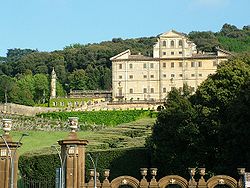Frascati
It is located 20 kilometres (12 mi) south-east of Rome, on the Alban Hills close to the ancient city of Tusculum.
In the first century AD its owner was Gaius Sallustius Crispus Passienus, who married Agrippina the Younger, mother of Nero.
The name of the city probably comes from a typical local tradition of collecting firewood ("frasche" in Italian)—many place-names around the town refer to trees or wood.
Pope Innocent III endorsed the city as a feudal possession of the basilica of San Giovanni in Laterano, but in the following centuries its territories were ravaged by frequent raids that impoverished it.
It was owned by various baronial families, including the Colonna, until, in 1460, Pope Pius II fortified the city with walls.
After Prince Colonna's death in 1522, Lucrezia della Rovere sold Frascati to Pier Luigi Farnese, nephew of Pope Paul III.
However, the soldiers changed the direction of their movement next to a niche, a "Rural Aedicule" consecrated to the Virgin Mary, and the town was therefore saved.
On June 18, 1656, a part of the plaster peeled off a wall inside the Church of St. Mary in Vivario, and an ancient fresco became visible.
In 1757 the Valle theater opened in the centre of the town, and in 1761 the fortress changed to a princely palace under the patronage of Cardinal Henry Stuart, Duke of York.
The trams traveled wholly along tracks laid down on existing streets as an interurban electric streetcar (light rail).
In 1943, during World War II, Frascati was heavily bombed because it contained the German General Headquarters for the Mediterranean zone.





